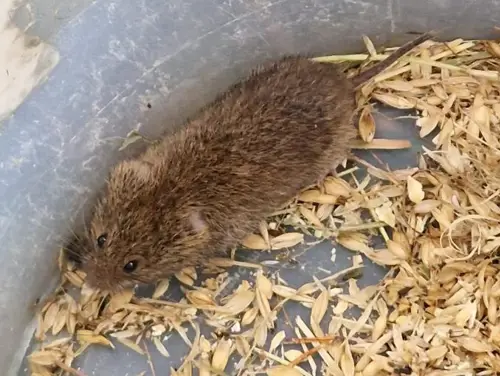Field voles: the Cairngorms' most important mammal?
 Is the humble field vole the Cairngorms' most important mammal? As unassuming as they might seem, field voles play a key part in the food chain and their numbers can have a huge impact on protected species like capercaillie.
Is the humble field vole the Cairngorms' most important mammal? As unassuming as they might seem, field voles play a key part in the food chain and their numbers can have a huge impact on protected species like capercaillie.
That's why, twice a year in autumn and spring, ecologists survey voles in the Cairngorms Connect project area. The project area covers over 60,000 hectares of the national park and aims to restore its habitats, species and ecological processes.
We collaborate with Cairngorms Connect Predator Project partners to carry out these surveys to estimate the number of short-tailed field voles, bank voles and wood mice present in their Cairngorm forests.
Kenny Kortland, our wildlife ecologist and lead on the Cairngorms Connect Predator Project, said:
“We’re particularly interested in the abundance of field voles, which could be described as the most important species in the Cairngorms ecosystem.
They have a huge influence on the system, as they are the main food of carnivores such as pine martens and foxes, which are the main predators of rare species like capercaillie.
“We survey voles in spring and autumn because we want to know how abundant they are during the breeding season of other species, such as capercaillie.
“Field vole populations go up and down in a regular cycle, over the course of a few years. When vole numbers are low, the predators will switch to other food sources.
“Recent work in this area has shown that pine martens will switch to shrews and small birds, while foxes will switch to deer carrion and, believe it or not, dog poo.
"Both foxes and pine martens will also eat small numbers of protected species, such as capercaillie, and by understanding the vole cycle, as well as the ecology of the predators, we can manage and protect the rare species more effectively.
"When vole numbers are high, we probably don’t need to do much, but when vole numbers are low, we may have to act to reduce capercaillie predation. For example, by providing extra food to divert predators away from capercaillie."
Cosy traps and tiny poos
PhD student Jack Bamber from the Cairngorms Connect Predator Project worked on the autumn vole survey with us. He spent three weeks in the Cairngorms counting voles and mice:
“Field voles are tiny, about 10cm long, and hard to spot in the long grasses that they prefer. We look for their droppings, both old and new, which are tiny and easily identifiable. We also look for chewed bits of grass. From the counts of these signs, we can calculate the abundance of the field voles.
“Bank voles are about the same size and there are a lot of them living in the Cairngorms’ forests. They’re eaten less often than field voles, probably because they live in the forests and spend quite a bit of time in the trees.
“For bank voles and wood mice, which don’t leave obvious signs of their presence, we set very cosy traps that are filled with carrots and oats.
Some of the voles get a bit trap happy and keep coming back, because they know there’s good food in there, so we have to account for that in our results.
